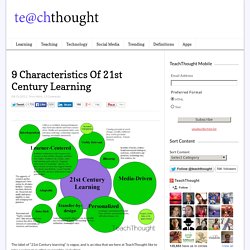

Leerpsychologie - Robert Jan Simons. Robert Jan Simons Prof.

21st Century Pedagogy. Even if you have a 21st Century classroom(flexible and adaptable); even if you are a 21st Century teacher ; (an adaptor, a communicator, a leader and a learner, a visionary and a model, a collaborator and risk taker) even if your curriculum reflects the new paradigm and you have the facilities and resources that could enable 21st century learning – you will only be a 21st century teacher if how you teach changes as well.

Your pedagogy must also change. Definition: pedagogy - noun the profession, science, or theory of teaching. Source: Key features How we teach must reflect how our students learn. Knowledge Knowledge does not specifically appear in the above diagram.
Alphabetic list of Theories. Literature Review: Learning Theories Supporting Peeragogy. Www.danoff.org/leftinfront/wp-content/uploads/downloads/2013/01/peeragogy-shell-v1.pdf. Www.tagoras.com/docs/Learning-20-Associations-2ed.pdf. 9 Characteristics Of 21st Century Learning. The label of “21st Century learning” is vague, and is an idea that we here at TeachThought like to take a swing at as often as possible, including: –weighing the magic of technology with its incredible cost and complexity –underscoring the potential for well thought-out instructional design –considering the considerable potential of social media platforms against its apparent divergence from academic learning Some educators seek out the ideal of a 21st century learning environment constantly, while others prefer that we lose the phrase altogether, insisting that learning hasn’t changed, and good learning looks the same whether it’s the 12th or 21st century.

At TeachThought, we tend towards the tech-infused model, but do spend time exploring the limits and challenges of technology, the impact of rapid technology change, and carefully considering important questions before diving in head-first. The size of the circles on the map are intended to convey priority. Www.johnseelybrown.com/Re-Imagining Dewey.pdf. Free learning styles inventory (test, quiz or questionnaire), including graphical results. Bloom's and ICT tools. Many teachers use Bloom's Taxonomy and Bloom's Revised Taxonomy in developing and structuring their teaching & learning experiences.

Bloom's Digital taxonomy is an attempt to marry Bloom's revised taxonomy and the key verbs to digital approaches and tools. This is not a replacements to the verbs in the revised taxonomy, rather it suppliments and supports these by including recent developments, processes and tools. This page looks at some specific examples of tools and match them to Bloom's Digital Taxonomy Many of these tools that are FOSS (Free or Open Source Software). These are in italics. Some tools are marked with abbreviations as they cover a variety of tools.Main pageTraditional and Digital approaches Benjamin Bloom developed, in the 1956 while working at the University of Chicago, developed his theory on Educational Objectives. Files Web 2.0 Tutorials Without a doubt one of the best resources on the web for web2.0 Technologies is the commoncraft show.
Upload.wikimedia.org/wikipedia/commons/5/5a/Learning_Theories.pdf. Www.stanford.edu/class/ed269/hplintrochapter.pdf. Learning Theories. Leren & leertheorie. Leren en leertheorieën De belangrijkste leertheorieën die we op dit moment kennen zijn: BehaviorismeCognitivismeConstructivisme en een variant daarop het Sociaal constructivismeConstructionismeConnectivisme De volgorde waarin deze leertheorieën staan is tevens de volgorde waarin ze zijn ontstaan, waarbij het behaviorisme de oudste leertheorie is.
Wat leren is, wordt vanuit verschillende leertheorieën op een andere wijze beschreven. De behavioristische visie gaat er bijvoorbeeld van uit dat leren gelijkgesteld kan worden aan het verwerven van observeerbaar gedrag en dat leren plaatsvindt door bekrachtiging van een gedragsreactie van de lerende op een stimulus. Dit is natuurlijk een erg ingekorte typering van de leertheorieën. Omdat in iedere leertheorie op een andere wijze tegen “leren” wordt aangekeken, worden vanuit deze leertheorieën ook andere instructiemethoden bedacht en wordt het gebruik van e-learning daarbinnen op andere wijzen ingepast. Recycling Kolb. David a. kolb on experiential learning. Contents: introduction · david a. kolb · david kolb on experiential learning · david kolb on learning styles · issues · developments – jarvis on learning · a guide to reading · links · how to cite this piece As Stephen Brookfield (1983: 16) has commented, writers in the field of experiential learning have tended to use the term in two contrasting senses.

On the one hand the term is used to describe the sort of learning undertaken by students who are given a chance to acquire and apply knowledge, skills and feelings in an immediate and relevant setting. Experiential learning thus involves a, ‘direct encounter with the phenomena being studied rather than merely thinking about the encounter, or only considering the possibility of doing something about it.’ (Borzak 1981: 9 quoted in Brookfield 1983). The second type of experiential learning is ‘education that occurs as a direct participation in the events of life’ (Houle 1980: 221). Experiential learning articles + critiques of David Kolb's theory. KijkopLeren0910 - Constructivisme. Get your brand new Wikispaces Classroom now and do "back to school" in style. guest Join | Help | Sign In KijkopLeren0910 Home guest| Join | Help | Sign In Turn off "Getting Started" Loading...